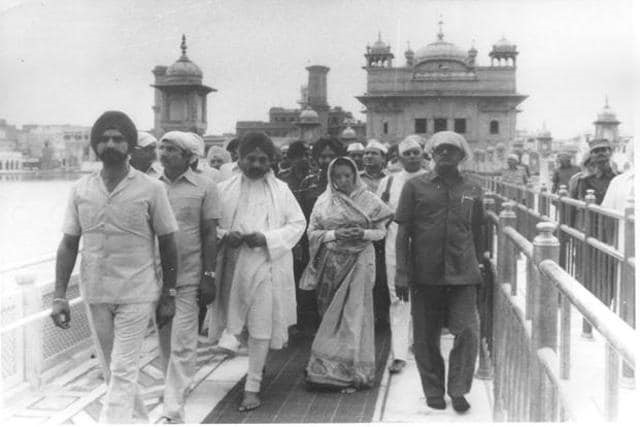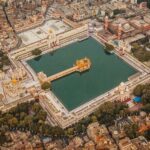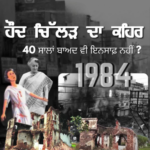The 1984 Blue Star Operation the true story was the hugest security mission ever undertaken by the Army of India. Operation Blue Star was Prime Minister Indira Gandhi solution to the out of order going law and order circumstance in state of Punjab. Operation Blue star which started on June 3-8, 1984 completes many years at present. On this occasion, we all take a sight at the incident that hit back the 1984 anti-Sikh riots and its after-collision
Blue Star was a military functioning which was ordered by Prime Minister, to eliminate Sikh militants who were amassing weapons in Golden Temple or the Harmandir Sahib Complex in Amritsar, in order to set up control over it. The functioning was carried out by the Indian Army in 1984 to get rid out of militants hidden in the Harmandir Sahib or the Golden Temple complex, in Amritsar. The Prime Minister of India Indira Gandhi, instructed the military operation to eliminate Sikh militants who were assemble weapons in the Golden Temple.
(At present, Amritsar in Punjab state has transformed into a virtual fort with Blue Star’s 35th anniversary. Over thousands of security personnel have been positioned and police are continuing a hawk-eyed vigil in sensitive regions.
Cops suspect that a militant firm, Khalistan Liberation Force, may attempt to develop noise in the Punjab in vision of Operation Blue Star’s anniversary.)
THE BIRTH OF BLUE STAR
Operation Blue Star had taken birth after the revolt of Khalistan movement in the country. Even though the movement had initiated in the early 1940s and 1950s, it obtained popularity between 1970s and 1980s. The operation was supported out by the Indian Army in 1984 to ruin out militants hiding in the Golden Temple or the Harmandir Sahib complex, in Amritsar. Between June 1 and June 8, 1984, It was conducted out within the premises of the temple.
Why was it carried out?
It all initiated with the progress of the Khalistan movement in the nation. It was a Sikh separatist movement, which aimed to develop a separate nation denoted as Khalistan in the Punjab zone, to serve as a home place for Sikh community. The movement is said to have began in early 1940s and 1950s. But, it extend its zenith in between 1970s and 1980s.
The movement obtained motion after Sikh religious leader Sant Bhindranwale connected with the movement. In 1982, he began the groundwork for his demand and by mid-1983, he headed to gain control for Khalistan’s formation.
In July 1982, he moved to Harmandir Sahib and took over the Akal Takht complex, where he began convincing that Sikhs must initiate a conflict for Khalistan. He then establish a base inside and was said to have get together a sizeable following of like-minded Sikhs. Jarnail singh had also reportedly store up weapons within the compound. Operation Blue Star was particularly aimed to remove out Jarnail singh from the temple.
The Operation and its consequences
Then- Indira Gandhi- Prime Minister of India ordered a military action to take back jurisdiction of the Harmandir Sahib from the armed militants. The operation was code-named ‘Blue Star’. As per to government authorities, hundreds of individuals were shattered in operation, including Bhindranwale.
Aftermath of Operation Blue Star
Though the holiness of the Harmandir Sahib was restored and militants and arms were removed from the temple, the action was heavily censured by many Sikhs. Months later, PM Indira Gandhi was murdered by two of her Sikh bodyguards for allowing the whole thing.
JARNAIL SINGH BHINDRANWALE
Sant Bhindranwale was the leader of Damdami Taksal and was one of the key basis behind Blue Star Operation. As a leader, Sant Bhindranwale had an impact on Sikh youth. He persuaded many individuals to follow Sikh guidelines and tenets.
During Operation, Jarnail singh and Khalistan supporters took over the Akal Takht complex in Amritsar’s Harmandir Sahib.
Jarnail singh was seen as a supporter of the formation of Khalistan. Blue Star Operation specifically was main purpose to withdraw off Sant Bhindranwale from the Harmandir Sahib complex and regain the control over Golden Temple.
Where did it all start?
The origin of Blue Star Operation can be track down from the Khalistan workings as it was a political Sikh nationalist development that needed to develop an independent state for Sikh individuals, inside the present North-Western Republic of India.
The Operation
It became necessary to carry out the operation blue star as it had two parts to it. The initial one was Operation Metal, which was cramped to the Golden Temple or the Harmandir Sahib complex. Operation Metal was come after by Operation Shop. It attacked the Punjab countryside, in order to catch any suspects.
Succeeding it, Operation Woodrose, the second constituent, was set up throughout Punjab state. The operation was set out by Indian Army. Operation Blue Star was set out to get rid of Jarnail Singh Bhindranwale and other sikh activist who had taken placed out in the Amritsar Golden Temple Complex. The complete stuff lasted for ten days. It began on June 1, 1984 and ended on June 10, 1984. Timeline of significant dates:
June 1, 1984: ‘Guru Ram Das Langar’ building inside the Harmandir Sahib was bombard by the Indian Army. At that attack, around 8-10 individuals died.
June 2, 1984: Estimated seven divisions of army were placed to Punjab state. During that time, Media face out a blackout and transit also bear a vital setback. Outsiders were refused out for entry. In many chunks of Amritsar, electricity and water supply was cut off.
June 3, 1984: Punjab state faced a absolute curfew as the para-military and army were patrolling around. Golden temple entries and exists were fully sealed.
June 4, 1984: Ramgarhia Bungas, inside the Golden Temple Complex was bombed. Ordnance QF 25 pounder was utilized to strike the Sikh militants. former head of SGPC (Gurcharan Singh Tohra), was arranged to reach an agreement with Bindrawale. However, the settlement had dissolved.
June 5, 1984: Brahm Boota Akhara and Hotel Temple View, on the southwest border of the compound was strike out by CRPF and BSF.
June 6, 1984: Army utilized tanks to demolish the Akal Takhat.
June 7, 1984: army of India had gained control over Golden Temple complex.
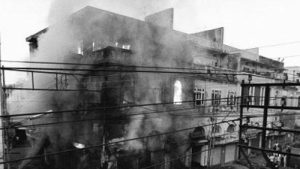
Media Blackout
During the Blue Star Operation, the punjab media confront a blackout. Journalists were reportedly were deserted at border of Haryana. In that time, Punjab faced a curfew condition. Journalists who tried to get into Punjab were refused entry. Indian nationals, who were employed for foreign media were also refused entry into the state. All these events led to hard criticism towards the gov.
Anit-Sikh Riots
Killing Of Indira Gandhi led to the Anti-Sikh Riots across the country. After the murder of Indira Gandhi on October 31 1984, anti-Sikh riots had taken place on 1 November 1984. It continued for a few more days timeline, which killed more than 3,000 Sikhs.
The worst affected zones were Trilokpuri, Mangolpuri, Sultanpur, and other Trans-Yamuna regions of Delhi. Mobs made utilization of combustible material such as petrol and kerosene, iron rods, and knives. The mob strike Sikh neighbourhoods, mercilessly killing any Sikh women and men they could discover. Their homes and shops were burned and destroyed. In other incidents, armed mobs also bring to a stop to trains and buses, in and around Delhi. They dragged out Sikh passengers, who were drenched with kerosene and burnt alive. Others were pulled out from their houses and attacked with steel weapons.
Throughout the night time of Oct. 31 and morning of Nov. 1, Congress party officials met the regional supporters to distribute weapons and money. Bottles of liquor and 100 rupee notes were handed out to the mob. It is also said that police of Delhi kept its ‘eyes closed’ during the rampage as it was all pre-planned. On October 31, Congress leaders offered the mob with ration lists and voter lists. The lists were utilized to explore the location of Sikh business and homes, Without the lists, it would have been an quiet impossible piece of work to locate the Sikhs.
Operation Black Thunder
India saw a redo of Blue Star Operation a few years later. Black Thunder was the name given to two operations that had taken place in the country in the late 1980s, to ruin out remaining Sikh reformers from the Golden Temple. ‘Black Cat’ commandos of the NSG were utilized in this operation. Same to Blue Star Operation, these assaults were towards Khalistani supporters who were utilizing the Temple in as a base. The foremost Black Thunder Operation had taken place on April 30, 1986. The second Black Thunder Operation started on May 9, 1988. The operation was leaded by Kanwar Pal Singh Gill (Punjab Police DGP). Tiny damage was imposed on the Golden Temple, compared to Blue Star Operation. Black Thunder was pretty more successful, in comparison to Blue Star Operation.
Casualties according to Indian government.
Civilians: 493 dead
Military: 136 killed and 220 wounded.
Criticism
The Blue Star Operation was condemned for its no holds barred structure. During the Operation, journalists were denied entry and the media in punjab faced a blackout. In that scenario, Punjab encounter a curfew and there was no transit across the state. Indians working for foreign media were also refused entry. This led to heavy censure towards the central government. Succeeding the Blue Star Operation, 4000 Sikh soldiers express opposition of pan-India, leading a revolt against the gov.
DEATH TOLL
Official record put the number of civilian deaths at 492 and the number of deaths among the Indian army at 83, though independent guess ran quiet much higher.
OPERATION SUNDOWN
Sundown Operation was the terminated mission which was planned by the RAW agency to capture Bhindranwale.
OPERATION BLACK THUNDER
Black Thunder Operation was the second phase of Blue Star Operation. The foremost phase was carried out on April 30, 1986, while the second one Black Thunder started on May 9, 1988. It was executed by Black Cat commandos of NSG to eliminate Sikh militants from the Golden Temple.
Operation Blue Star was divided into two chunks
- Operation Metal asIt was restricted to Amritsar Golden Temple but it also open on to Operation Shop – the arresting of suspects from Punjab outskirts.
- Operation Woodrose was set up in motion throughout Punjab. The operation was set afloat out by Indian Army, utilizing armored vehicles, helicopters, artillery and tanks.
BARRING MEDIA
In 1984, the government face out a lot of backlash as they had prohibited media from entering Punjab altogether. Media broadcaster were put on a bus and were go off at Haryana border. As there was a curfew-circumstance in Punjab, no mode of transport was accessible for them to travel. Whoever reached was not permitted to get into Punjab as well.
THE AFTERMATH
The military hit led to stress across members of Sikh community worldwide.
THE REVENGE
Prime Minister Indira Gandhi was killed by two of her Sikh bodyguards on October 31, 1984, for giving consent for the Blue Star Operation.
Indira Gandhi Assassination
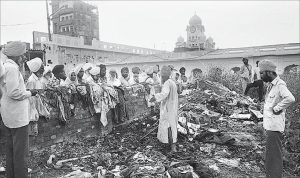
The Blue Star Operation became the key reason of Indira Gandhi’s death. Indira Gandhi was killed by her Sikh bodyguards, on October 31 1984, Beant Singh and Satwant Singh, four months after the incident. Post Indira’s assassination, anti-Sikh riots had taken place and continued for some more days, which killed more than 3,000 Sikhs.
What was the purpose of Blue Star Operation?
Bluestar Operation was aimed at offset militant Sikh minister of religion Jarnail Singh Bhindrawale and his band of armed supporters settled in the Golden Temple complex in Amritsar. It’s been 37 years since the Indian Army managed an operation to eat away militants from the Golden Temple in Punjab, in June, 1984.
Was the Blue Star Operation successful?
Blue Star Operation was victorious in the manner that it has killed the volume of the separatists, but the army mission was an total failure as it dissolve out to prevent the complete demolition of the Akal Takht and Harmandir Sahib
Who Killed Blue Star?
General Arun Shridhar Vaidya
General Arun Shridhar Vaidya, the Chief of Army Staff at the time of Blue Star Operation, was killed in 1986 in Pune by Sikhs, Sukhdev Singh Sukha and Harjinder Singh Jinda. Both were impose a sentence to death, and hanged on 7 October 1992.
Who has attacked Golden Temple?
In a blood thirsty climax to two years of conflicting between the Sikh separatists and Indian government, Indian army troops fight their manner into the shut off Golden Temple compound in Amritsar–the sacred temple of Sikhism–and kill at least 500 Sikh rebels.
When did Operation Blue Star end?
1 June 1984 – 8 June 1984
What is Khalistan movement?
The Khalistan issue is a Sikh separatist development seek out to generate a home place for Sikhs by setting up a sovereign state, denoted as Land of the Khalsa, in the Punjab zone. The proposed state would comprised of land that presently forms Punjab, Pakistan and Punjab, India.
Is Golden Temple built of gold?
It’s all construct up of 24-karat gold, which is pretty purer than the 22-karat gold available in Indian households today.
What was Blue Star Operation and Why did it hurt the sentiments of the Sikh community?
Blue Star Operation was an army action in the Harmandir Sahib, Amritsar to tear out the militants. · This operation destroyed the historical temple and harm the sentiments of Sikh society as they had seen military action as an attack to their faith.
Who built Golden Temple?
The Golden Temple or Harmandir Sahib in Punjab, India, c. 1870s. The foremost Golden Temple was constructed in 1604 by Arjan, the fifth Sikh Guru, who emblematic had it placed on a lower level so that even the kindest had to step down to enter it.
How many soldiers died in operation Blue Star?
The official casualty figures for the army were 249 injured and 83 dead.
How many army personnel died in operation Blue Star?
During Blue star Operation, the great estimate of the total number of deaths extent from 5,000 to 7,000. It was a disaster that could have been ignored if – and it is a large if – Indira Gandhi had had the clear imagination to reach out a political settlement with the modest Akali leadership.
Who has killed Arun Vaidya?
From 1983 to 1986, Arun Vaidhya set out as the 13th Chief of the Army Staff. After his retirement, Arun Vaidhya was killed by Sukhdev Singh Sukha and Harjinder Singh Jinda, in August 1986, Sikh militants of the Khalistan Commando Force. This was done in revenge of Operation Blue Star.
Is Sant Bhindranwale alive?
Deceased (1947–1984)
Who built Amritsar?
Sri Guru Ramdass ji
Amritsar was set up by Sri Guru Ramdass ji, the fourth Sikhs guru in about 1574 A.D. Before the town was founded, the region was covered with pretty thick forests and had some lakes.
Who had built up the Amritsar temple?
The temple – which is also familiar as Darbar Sahib – is in the town of Amritsar which was founded in 1577 by the fourth Sikh guru, Guru Ram Das with the fifth, Guru Arjan designing the pagoda. The house of worship began to be built in 1581 with the foremost version of the stupa taking eight years.
Which Almighty is Worshipped in Golden Temple?
English: The Darbar Sahib also Harmandir Sahib or the Golden Temple (on account of its pretty beauty and golden coating for English speaking Globe), is named after Hari(Almighty) the temple of God as it is an eminent Sikh Gurdwara situated in the city of Amritsar, Punjab,India, is the sacred shrine in Sikhism.
When was Indira Gandhi shot?
31 October 1984. Indian Prime Minister Indira Gandhi was murdered at 9:29 a.m. on 31 October 1984 at her home place in Safdarjung Road, New Delhi. She was assassinated by her Sikh bodyguards in the fallout of Operation Blue Star.
What is the Operation Blue Star in English?
New Delhi, June 01: Operation Bluestar, a military operation was taken out in June 1984 to remove armed militants who were holed up in the Golden Temple. The operation had to be taken out in order to get back the jurisdiction of the Harmandir Sahib or Golden Temple from the militants.
What occurred to the murderers of Indira Gandhi?
Both Sikhs, Satwant Singh and Beant Singh, empty out their guns into Gandhi as Indira Gandhi walked towards her office from an neighbouring bungalow. Although the two assailants straight away surrendered, they were both shot in a subsequent struggle, and Beant died.
What occurred to Jarnail Singh Bhindranwale body?
The body of Sant Bhindranwale, the militant Sikh leader killed during an army hit on the Golden Temple, containing 14 bullet wounds, involving six in the head, as per autopsy turn up from Punjab quoted in the newspaper Indian Express.
What is inside in the Golden Temple?
The gold-plated building marks white marble walls and copper cupolas caked with valuable stones arranged in decorative Islamic-style floral structure. The construction is decorated inside and out with poetry from the Granth Sahib (the Sikh holy book).
What time line Indira Gandhi shot?
Indira Gandhi( Indian Prime Minister) was killed at 9:29 a.m. on 31 October 1984 at her home in Safdarjung Road, New Delhi.
| Assassination of Indira Gandhi | |
| Date | 31 October 1984 9:29 a.m. |
| Attack Kind | Gun violence |
| Weapons | Sterling submachine gun and .38 (9.1mm) revolver |
| Assailants | Beant Singh and Satwant Singh |
Where is Indira Gandhi belongs to?
Prayagraj
What happened to Satwant Singh and Beant Singh?
Beant Singh was shot to death during questioning in charge soon after the assassination. Satwant Singh was arrested and later pass judgement to death by hanging along with co-conspirer Kehar Singh. The ruling was carried out on 6 January 1989.
Can we wear out black in Gurudwara?
As far as I explore, there is no specific gideline ‘ regarding what type of clothes one must be wearing while enter into a Gurudwara. It does not matter as long as the clothes are decent and the head is covered.
